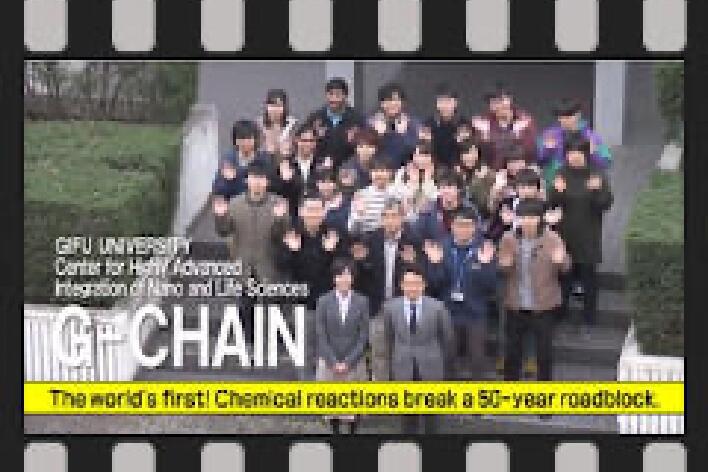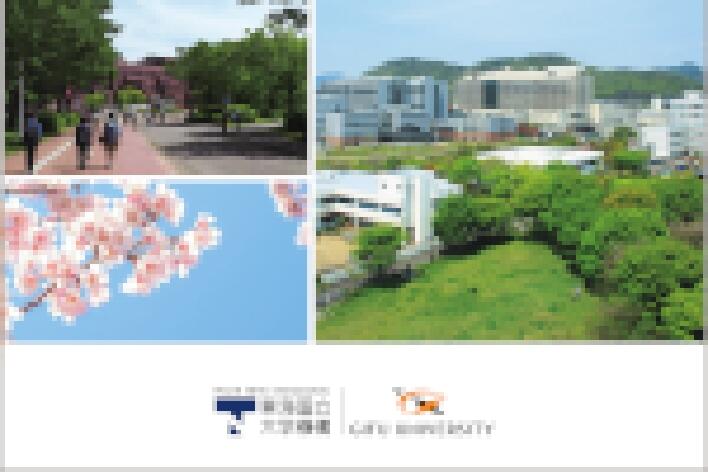"Photovoltaic power generation" is entering an era of practical use through cooperation with industrial circles.
We collaborate beyond the boundaries of research fields.
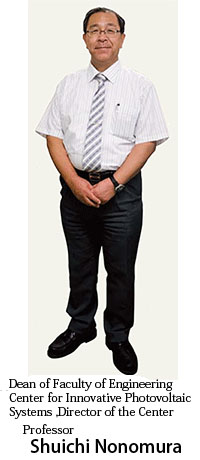
Seven research groups are conducting R&D of photovoltaic power generation
Our center is conducting research and development of new systems of photovoltaic power generation with seven research groups that have research laboratories in different fields including the Faculty of Engineering, Faculty of Regional Studies, and Faculty of Applied Biological Sciences. Among such systems, thin film silicon solar cells made from amorphous silicon were developed by Gifu University for the first time in Japan. It was the third such research and development in the world. Amorphous silicon is ultrathin silicon of 200 nano-meter* in thickness. Since the silicon is a light and soft material and lends itself well to are-production, it can be used in places of various shapes such as roofs and walls. At present, we are also developing materials that can deliver much higher performance.
Moreover, we are developing technology that can evaluate the performance of those thin film silicon solar cells in terms of atomic structure, while promoting research into dye-sensitized solar cells that absorb sunlight with dye and convert it into electricity. Furthermore, jointly with overseas researchers, we are conducting research into predicting solar power generation by calculating the amount of solar radiation based on an analysis of weather forecasts.
* nano-meter: A unit of length in the International System of Units. 1 nano-meter is 0.000001 mm.
We are contributing to society by putting solar cells into practical use via applications to communities and agriculture.
Solar cells have entered an era of practical use from the research and development phase. Major manufacturers are making efforts to reduce prices. Automobile manufacturers are developing electric vehicles that can run long distances using electricity stored in household photovoltaic power systems. If we can share electricity and automobiles using the electricity stored in mega-solar systems located every several villages and towns apart, it will regenerate and revitalize local communities in the future. Moreover, our center has also embarked on applications in agriculture. We are exploring, for example, new applications of solar cells by installing low-cost cooling systems in poultry farms.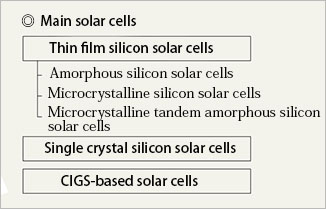
We can conduct such diverse research and activities simply because laboratories are "horizontally" connected. Since we put no restraints on the research being conducted by laboratories, they can produce better results. We want to continue pursuing development that can contribute to society in the future.
Research and development being conducted by the Center of Innovative Photovoltaic Systems
- "Thin film silicon solar cells" that lend to mass-production at low cost
- "Photovoltaic microscope" that evaluates the performance of "microcrystalline silicon solar cells"
- Evaluating the structure of a 1m2 photovoltaic module (panel) Evaluation technique based on "ellipsometry"
- New material that improves generating efficiency "Silicon clathrate"
- A system that "smartly" controls the balance between the supply and demand of electric power "Smart-grid" (Next-generation power network)
- Red, yellow, green, and clear-and-colorless solar panels "Dye-sensitized solar cells"
"Thin film silicon solar cells" that lend to mass-production at low cost
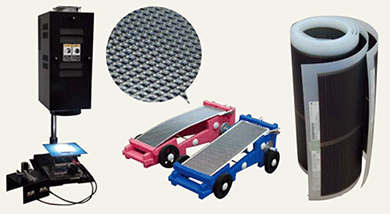
(center)Solar car equipped with ball-shaped silicon solar cells,
(right)Light, soft and thin film silicon solar cells
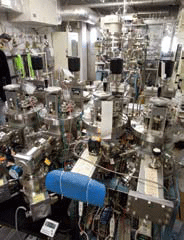
solar cells manufacturing equipment
Thin film silicon solar cells are made mainly from "amorphous silicon" and "micro-crystalline silicon". We aim to enhance the efficiency of thin film silicon solar cells by developing chief materials using plasma technology and by conducting research into the structure and electric and optical properties of the cells we have made.
Electrical and Electronic Course, Department of Electrical, Electronic and Computer Engineering, Faculty of Engineering
(Thin Film Silicon Solar Cells R&D Group)
Shuichi Nonomura Professor and Associate Dean
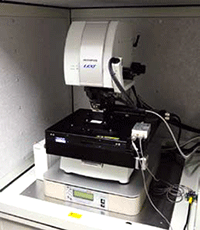
the local characteristics of solar panels
using ultrathin probes.
"Photovoltaic microscope" that evaluates the performance of "microcrystalline silicon solar cells"
We have developed a "photovoltaic microscope" to evaluate the local characteristics of micro-crystalline silicon solar cells. Using the microscope, we trace the surface of micro-crystalline silicon with the 20-nanometer* ultra thin probe to observe the shape. And, by flowing electricity and applying light to it, we observe the operating conditions of the electric current. Thus, we are developing a mechanism for evaluating the local performance of solar cells in cooperation with companies.
Electrical and Electronic Course, Department of Electrical, Electronic and Computer Engineering, Faculty of Engineering
(Thin Film Silicon Solar Cells R&D Group)
Takashi Ito Associate Professor
Evaluating the structure of a 1m2 photovoltaic module (panel)
Evaluation technique based on "ellipsometry"
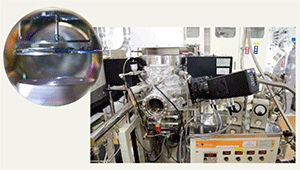
for HIT solar cells
"Ellipsometry" is a method of collecting information on a material by observing the state of polarization when polarized light is reflected on the surface of the material. We are jointly conducting research with private sector companies into new technologies for evaluating a large 1 m2 solar panel based on this method. We evaluate film structures by exposing thin film silicon solar cells to light and observing the reflected light in order to identify the optical characteristics and thickness of the material.
Electrical and Electronic Course, Department of Electrical, Electronic and Computer Engineering, Faculty of Engineering
(Solar Cell Module Characterization R&D Group)
Hiroyuki Fujiwara Professor
New material that improves generating efficiency"Silicon clathrate"
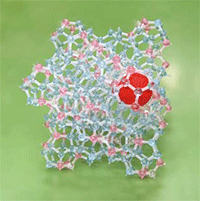
"Silicon clathrate" has a cage-like crystal structure that is made when sodium is contained in the diamond structures of silicon atoms. We have developed such "silicon clathrate" as a new material for solar panels. Since silicon clathrate changes its properties according to its contained materials, it can largely diversify the applications of silicon. Moreover, if sodium is removed after the change of structure, it becomes a new semiconductor silicon clathrate, which is expected to improve the efficiency of power generation.
Electrical and Electronic Course, Department of Electrical, Electronic and Computer Engineering, Faculty of Engineering
(Thin Film Silicon Solar Cells R&D Group)
Tetsuji Kume Associate Professor
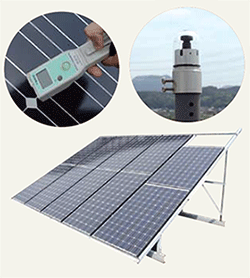
universities facilities. We observe movements of
clouds with the small camera (center top) and
measure temperature with the infrared camera (left)
to check for trouble, with the aim of studying
their effects on power generation.
A system that "smartly" controls the balance between the supply and demand of electric power
"Smart-grid" (Next-generation power network)
Power generation by solar cells is affected by cloud movements, weather phenomena such as the amount of solar radiation and temperature, the angle of the panels, aged deterioration, and so forth. Therefore, we are conducting research into how to correctly estimate power generation and establish optimal electricity supply systems in combination with fuel cells and storage batteries. Moreover, we have developed a demonstration "smart-grid (next-generation power network)" that controls the balance between power supply and power demand over a computer network, and are operating the system in the Flower Festival Commemorative Park in Kani City.
Electrical and Electronic Course, Department of Electrical, Electronic and Computer Engineering, Faculty of Engineering
(Hybrid Energy System R&D Group)
Hiroki Yoshida Associate Professor
Red, yellow, green, and clear-and-colorless solar panels
"Dye-sensitized solar cells"
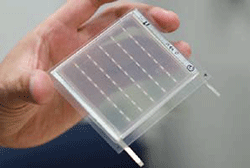
This solar cell generates only a small amount of
power, but it is expected that the cell can be
applied to a wide range of places such as windows.
We are studying dye-sensitized solar cells that generate electricity using dye that absorbs sunlight. In particular, we have developed "see-through solar cells" that use nearly clear-and-colorless dye. Such a dye absorbs only infrared rays that account for more than half of the components of sunlight. If these "see-through solar cells" are attached to windows, they permit the passage of visible light and change only infrared rays into electricity.
Materials Chemistry Course, Department of Chemistry and Biomolecular Science, Faculty of Engineering
(Dye-sensitized Solar Cell R&D Group)
Kazumasa Funabiki Associate Professor
* The group name in parenthesis identifies the group at the Center of Innovative Photovoltaic Systems (Organization for Research and Community Development) where each professor or associate professor additionally holds a post.


